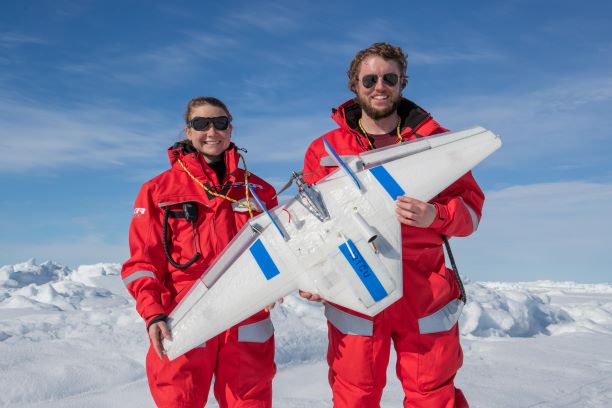by Radiance Calmer, a CIRES postdoctoral researcher
It’s 3:30 pm. I join Jonathan (Hamilton) in the Red Salon of the Polarstern and collapse in the armchair beside him. We are both exhausted and looking with envy to our first piece of cake for the entire week. Harold, one of the helicopter pilots, joins us. He glances at the screen on the wall, which shows a live video of the floe at the bow of the ship. It’s foggy outside. Then he looks at us and says: “You’re not outside today? You guys are flying all the time!” Jonathan answers: “We flew last night”, to which Harold retorts seriously: “There is no night!” We all laugh.
Once we have boarded the Polarstern and got access to the drones and our materials, our schedule has been very intense. The Datahawk, the small fixed wing that has already flown during Leg 3 of MOSAiC, has been straightforward to get ready. Accessing the other platforms buried in warm storage, outside containers, or exposed wooden crates on the deck has been another story. After a few working days in the lab, we were glad to see the RAAVEN, the larger fixed wing, finally assembled and prepared to fly. We were also optimistic with the copter capabilities.
After establishing the new location of the Polarstern on the floe, we picked a site on the first-year ice between the ROV oasis and the albedo lines. This field is quite isolated and gives us a nice area for our drone flights. Being at the edge of the floe, we have been granted an ocean view and numerous melt ponds over the past few weeks. It’s a really nice walk to access the new Droneville, we sometimes spot a seal checking on us.

Since we have arrived, we have been flying the drones as much as we can. The Datahawk has been a very reliable platform, providing profiles of the atmosphere from 20 to 1000 m. After some adjustments required by the fast drift of the ice, we have been able to successfully implement grid patterns with the copter for albedo measurements as well. However, the RAAVEN is still giving us some trouble with the payload that we hope to sort out shortly. We have reached 15 hours of flight over the past three weeks, and tested Jonathan’s piloting skills to avoid landing in the melt ponds. Yesterday, we took part of 24-hours of measurements organized in collaboration with all the science teams. We contributed with copter flights every 6 hours to compare albedo measurements with the ice team over the first-year ice. It was exhausting for us to be out in the field for two hours, come back to the ship, try to catch some sleep, then go back again 3 hours later to set up everything and fly the copter again. Yet, it was also so nice to work side by side with other teams and to be part of this intensive event! Now that instruments are running more or less, people are starting to share results and taking time to discuss science. It’s really exciting to see the pieces of the puzzle connecting to each other, and a glimpse of the bigger picture starting to reveal its colors.
